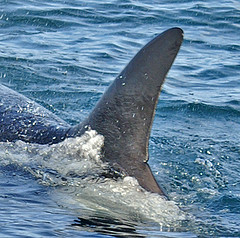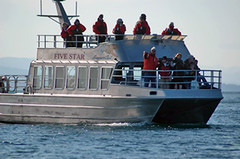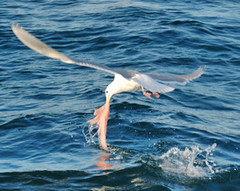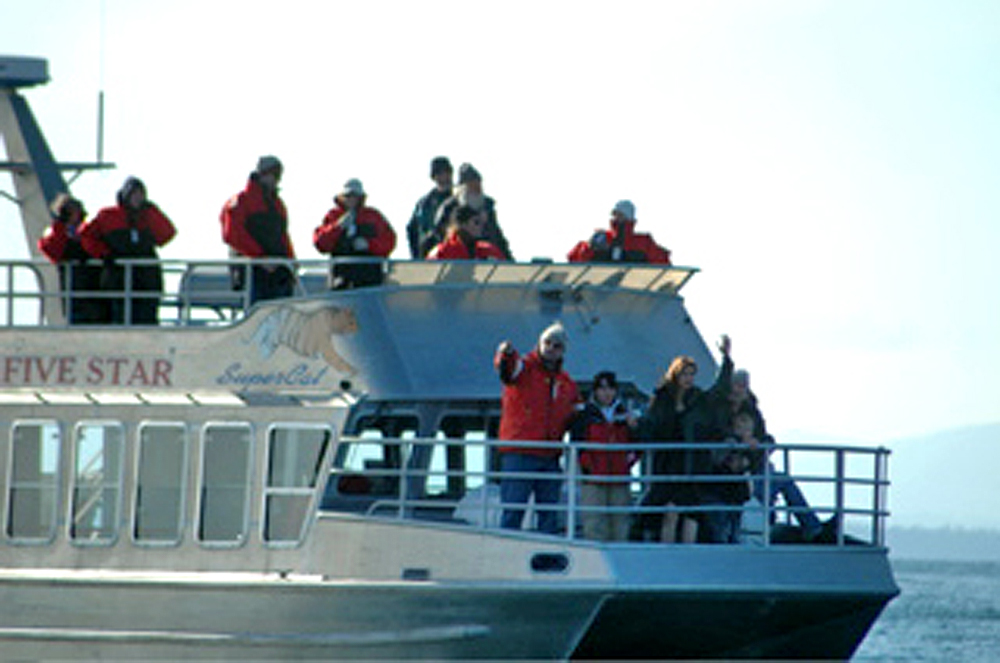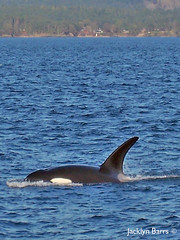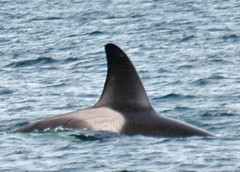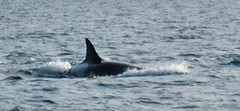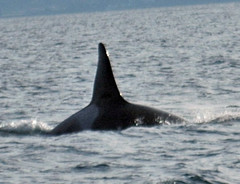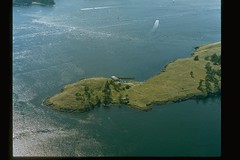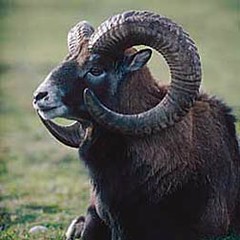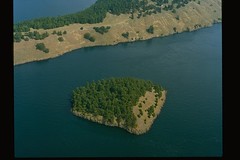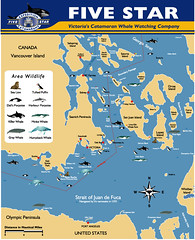The Steller Sea Lions started to gather near the eastern shore of green point and Capt. Trev pushed a little further in to the passage in search of old Minke Whale that was a old regular in the northern San Juans. Dozens of Harbour Porpoise fished in a tide rip, looking for squid or perhaps small herring. The porpoise bobbed all around the Supercat just a a few hundered feet away in the current. Harbour Porpoise are most often shay and we are always sure to not interrupt thier behavior. We do not often view them at length, the 15 minutes we spent with them was interesting and we discussed the Hybrid anomally whe have witnessed in Haro Strait.
Wednesday, March 22, 2006
Saturday, March 18, 2006
Thursday, March 16, 2006
Young male Salish Sea resident Orca J-33 "Keet"
J-33 has a unique nick on the trailing base of his dorsal fin. He is roughly 22 feet long and around 6 tons in size.
Tuesday, March 14, 2006
The Supercat finds Transient Orca in Haro Strait
What an amazing first trip of the season! Steller Sea Lions, exotic deer and Transient orca at Kelp Reef. It was warm and beautiful the whole afternoon. The snow capped Mountains and solitary waters made for a special expeience.
Read the entries below to come along on our first trip of the year. Kind regards, Jeff
Read the entries below to come along on our first trip of the year. Kind regards, Jeff
T 19 rests after rapid high breach attack. Credit: Jacklyn Barrs
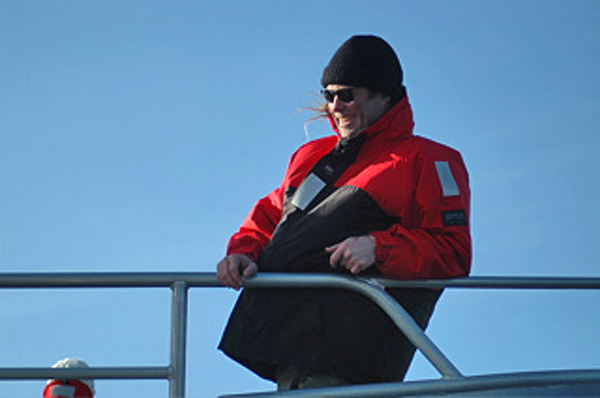
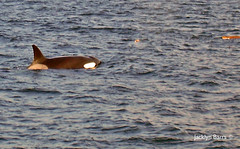
T 19 rests after rapid high breach attack. Credit: Jacklyn Barrs
Originally uploaded by Jeff Lorton.
We were all stunned at the whales ability to launch itself so high and far. In moment the other family were engaged in feeding on the attacked.
This was a dramatic turn of events in just a few seconds and the atmosphere on board was electric.
We were able to sit quietly for another 10 minutes and watch as the orca took turns diving to eat. This was truely a Five Star start to our 2006 Whale Watching Season. We all were in awe of the power and skill displayed by these great ocean predators.
I hope you share our desire that these beautiful and highly evolved whales are always both respected and protected.
What a great trip!
-Jeff
Monday, March 13, 2006
The Orca pod looks like the T-18s
Marine naturalist Jacklyn Barrs thinks she can ID the adult male in the group as T-19B or "Galiano". The calf is thought to be T-19C "Spouter". If true then the little critter is around 5 Years old. Credit: Jim Maya
Orca sighted at Kelp Reef!
Capt. Trev was bringing the Super Cat down Haro Strait at 4:15 PM. A warm breeze was upon the water and most of our company were up on the top deck talking about Orca natural history. I was scanning the shoreline below Mt Douglas, having just mentioned that side of the strait as being seemingly preferred by transient Orca when much to my surprise I saw a blow and fin about a half mile away! I shouted out "BLOW!" and pointed as Trev reduced speed. T 19B Dorsal. Credit: Jim Maya
Green Point Steller Sea Lions
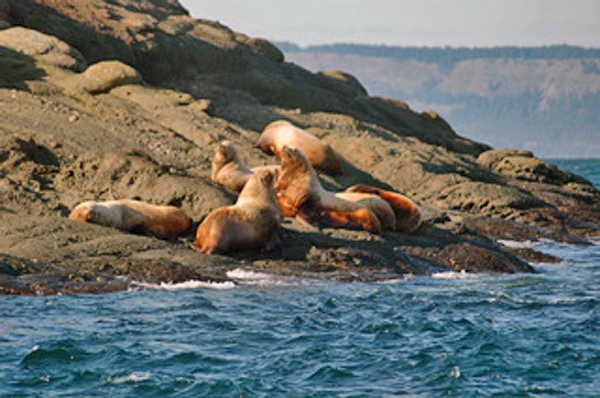
Each fall Steller Sea Lion males return to the protection of the inside waters. In spring the males return north to seek out the females. At Green Point we saw several large sea lions both "rafting" in the water and sunning themselves on the basalt rock shore. Learn more about Steller Sea Lions @
http://stellersealions.noaa.gov/
Green Point, Spieden Island, San Juan Group WA
A early spring hangout for Steller sea lions, green point is just a few miles north of Friday Harbor, San Juan Island.
Mouflon sheep, Sitka and Fallow deer.
In the 1970's a group of game hunting taxidermists in Seattle purchased the island and stocked it with exotic herd animals like Japanese Sitka Deer, European Fallow deer and the Corsican Mouflon sheep (Ovis musimon). The Mouflon is thought to be one of the two ancestors for all modern sheep breeds. Found in Corsica, it is red-brown with a dark back-stripe, light colored saddle patch and under-parts. The males are horned and the females are horned or polled. It is now rare but has been successfully introduced into central Europe, including Germany, Austria, Czech Republic, Slovak Republics, Romania and of course Spieden Island.
The island is still private but hunting was suspended long ago and today we saw the idyllic life of these beautiful exotic animals as they grazed the grassy slopes above the shore.
The island is still private but hunting was suspended long ago and today we saw the idyllic life of these beautiful exotic animals as they grazed the grassy slopes above the shore.
Spieden Island, San Juan Group WA
We crossed Haro Strait heading NNW and entered the San Juan group around 3PM skimming past the empty cormorant nesting cliffs of Kellit Bluff at 23 knots. We had only a brief sighting of a Dall's Porpoise near Kelp reef and were hoping to encounter Sea Lions near Spieden Island.
Sunday, March 12, 2006
First stop the Chain Islets
Our first stop after passing Trial Island Lighthouse was the Chain Islets. Right away we sighted one adult and one young Bald Eagle. A young man from Toronto spotted couple of Black Oystercatchers gliding in along the waters edge. The young raptor was sitting on top of the main Cormorant nesting site. The eagles own Great Chain and are looking forward predating on the cormorants young in a few months time. The islets are best described here:
The Chain Islets and Great Chain Island are located in Oak Bay, in the Juan de Fuca Strait, less than 2 km from the suburbs of Victoria, British Columbia. The site includes a cluster of at least 18 small islets and rocks in Mayor Channel. The low round islets are rocky and barren except for Great Chain Island that supports a nearly continuous grass and herbaceous cover and occasional shrub thickets. Shoreline features include a few steep faces, rocky outcroppings, boulders, crevices and small gravel beaches. The islets are surrounded by shallow water from which many rocky reefs emerge. Harbour Seals are regular in summer and the natural Gulf of Georgia meadow habitat, which has been eliminated by disturbance from most sites in British Columbia, supports rare flora such as Golden Indian Paintbrush, California Buttercup and Snakeroot Sanicle.
Birds
Chain Islets and Great Chain Island is a site of global importance, supporting a significant breeding population of Glaucous-winged Gulls, and a migratory population of Brandts Cormorants.
Additionally, 510 pairs of Double-crested Cormorants, which in British Columbia nest only in the Strait of Georgia, were recorded nesting in these islets. This is the second largest colony of this species in the province. Pigeon Guillemots and American Black Oystercatchers also nest on the islets, and Harlequin Ducks occur seasonally among the reefs and islands.
To learn more about this jewel in Victoria's crown check out this web site. http://www.bsc-eoc.org/iba/site.jsp?siteID=BC045
After leaving Oak Bay, we passed 10 Mile point and started our crossing of Haro Strait.
The Chain Islets and Great Chain Island are located in Oak Bay, in the Juan de Fuca Strait, less than 2 km from the suburbs of Victoria, British Columbia. The site includes a cluster of at least 18 small islets and rocks in Mayor Channel. The low round islets are rocky and barren except for Great Chain Island that supports a nearly continuous grass and herbaceous cover and occasional shrub thickets. Shoreline features include a few steep faces, rocky outcroppings, boulders, crevices and small gravel beaches. The islets are surrounded by shallow water from which many rocky reefs emerge. Harbour Seals are regular in summer and the natural Gulf of Georgia meadow habitat, which has been eliminated by disturbance from most sites in British Columbia, supports rare flora such as Golden Indian Paintbrush, California Buttercup and Snakeroot Sanicle.
Birds
Chain Islets and Great Chain Island is a site of global importance, supporting a significant breeding population of Glaucous-winged Gulls, and a migratory population of Brandts Cormorants.
Additionally, 510 pairs of Double-crested Cormorants, which in British Columbia nest only in the Strait of Georgia, were recorded nesting in these islets. This is the second largest colony of this species in the province. Pigeon Guillemots and American Black Oystercatchers also nest on the islets, and Harlequin Ducks occur seasonally among the reefs and islands.
To learn more about this jewel in Victoria's crown check out this web site. http://www.bsc-eoc.org/iba/site.jsp?siteID=BC045
After leaving Oak Bay, we passed 10 Mile point and started our crossing of Haro Strait.
Five Star Whale Watching Spring Transient 2006
4:30 PM March 11th 2006; Haro Strait - Kelp Reef - San Juan Island. Our first Super Cat trip of the year was very exciting! Capt. Trev, researcher Ron and I (naturalist-Jeff) we're really happy to be getting out on the water so soon this year. The Supercat departed Victoria Harbour with a dozen intrepid Canadian and Bosnian travelers looking for marine
wildlife. As usual, while I briefed the passengers on
the Catamaran's safety features Capt. Trev and Ron discussed the latest sightings in the past week and planned our route. Ron had knowledge of Resident Orca pods L-12 and K heading north up Swanson Channel the previous afternoon. He also knew there were Steller Sealions in the vicinity of Green Point on Spieden Island. We set out into light north easterly winds and warm sunshine.
wildlife. As usual, while I briefed the passengers on
the Catamaran's safety features Capt. Trev and Ron discussed the latest sightings in the past week and planned our route. Ron had knowledge of Resident Orca pods L-12 and K heading north up Swanson Channel the previous afternoon. He also knew there were Steller Sealions in the vicinity of Green Point on Spieden Island. We set out into light north easterly winds and warm sunshine.
Subscribe to:
Posts (Atom)



